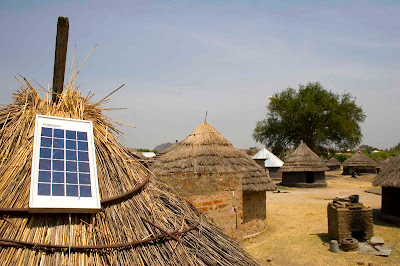But the spacing of the arms was defined by the gap needed to
fit two horses. So the spacing on of railway lines is defined by the entirely
irrelevant measure of an average horse’s rear.
This all changed with the car. Wheel spacing on cars can be whatever makes
sense for the vehicle- there’s no need to follow convention when the technology
has grown out of tradition methods.
It’s the same in off-grid energy. For many years, governments
have been working on ways to connect rural communities to the grid, but to what
end? 1.3 billion people worldwide, mainly those in hard-to-reach rural
communities, still live without electricity - how long would we have to wait to
connect them all in the conventional grid way?
Horse-and-cart methods just won’t work on a scale like this- we need to abandon the idea that Africa will become electrified in the same way as densely populated Western countries, and wake up to the possibility of new technology as a way forward. Africa is ready to jump over the industrial revolution and step straight into the information age by using the latest solar technology to solve the problem of rural electrification.
Horse-and-cart methods just won’t work on a scale like this- we need to abandon the idea that Africa will become electrified in the same way as densely populated Western countries, and wake up to the possibility of new technology as a way forward. Africa is ready to jump over the industrial revolution and step straight into the information age by using the latest solar technology to solve the problem of rural electrification.
There’s a fundamental difference in the kinds of power we’re
talking about. Solar creates low voltage “DC”. Mains electricity is high
voltage AC so it can be converted readily and travel long distances. However,
distributed power does not need to travel long distances and many devices such
as modern LCD TVs struggle to work with mains, needing to have an external
transformer to reduce it to low voltage DC.
When you think of electricity, the idea of making a coffee
of having a shower comes to mind. But users where electricity is scarce would
be horrified by such a wasteful idea. Electricity is a valuable resource and
used in small quantities for high value activities such as lighting, phone
charging and entertainment. Almost all of these solid-state devices run from DC
voltages very efficiently, so lets break the convention and define the DC
house.
The DC house has no high voltage- it’s efficient and works
well, with DC power running DC devices. With no high voltage, there’s no
electrocution risk- you’re not going to manage to kill yourself with 12 volts,
no matter how much water you pour over it. No electrocution risk means it’s
easier to install it and know it’s going to remain safe- a matter of importance
when the nearest technician is half a day’s bus ride into town. More
importantly, it can be installed in minutes, without the need for massive
electrification programs that can take years to deliver, if at all.
With this new power, families can enjoy the evenings
together, children can complete their homework and life is no longer tied to
the speed of rotation of the earth.
As a result, we have a new way of delivering home electricity
that does not rely on a quirk of history. It can be delivered by businesses as
well as governments who realise that the course of rural electrification
doesn’t have to rely on the metaphorical horse’s backside of grid connection.
Pippa Bransfield-Garth
In-house blogger, Azuri


Agreed!
ReplyDeleteThis prompts me to two questions:
1. Why is there no standard fitting for a 12v LED light bulb?
2. If someone is going to create a standard, should it be polarity-dependent?
Chris Moller, Cambridge
We agree. Standardisation of low voltage systems would be helpful, if nothing else to reduce costs and improve interoperability.
DeleteIt will certainly need to be polarity dependent to avoid reverse-biassing sensitive equipment but this should be simple enough.